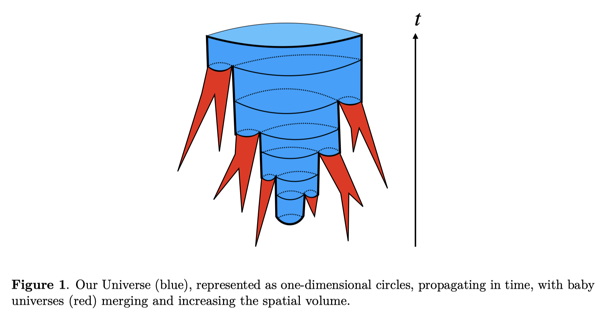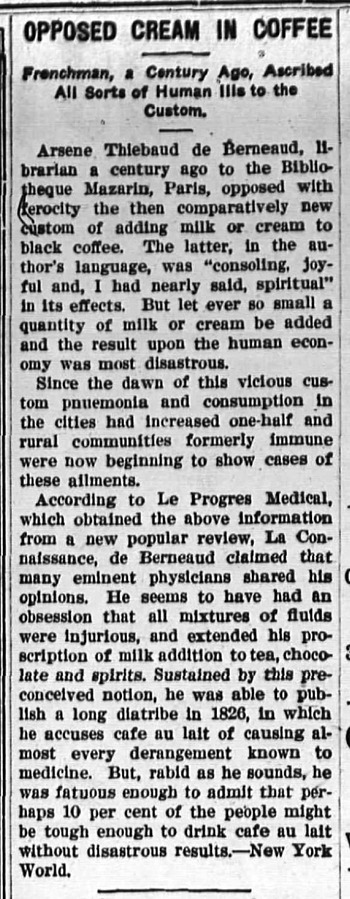Weird Theory
Are we swallowing other universes?
An unusual cosmological hypothesis was recently published in the Journal of Cosmology and Astroparticle Physics. At least, it's an idea I haven't heard before.It suggests that our universe has been swallowing "baby universes," and that this eating habit is the cause of the observed accelerating rate of expansion of our universe.

The article, authored by researchers from the Niels Bohr Institute and the Tokyo Institute of Technology, quickly veers off into mathematics that's incomprehensible to me. But I can extract a few interesting ideas. For instance, what if the initial "Big Bang" of our universe was caused by us (when we were still a baby universe) being swallowed by a larger universe?
And what would happen if, now that we're an adult universe, we collided with another adult universe? The researchers don't answer this question, but I'm guessing the outcome wouldn't be good.
More info: "Is the present acceleration of the Universe caused by merging with other universes?"
Posted By: Alex - Wed Mar 06, 2024 -
Comments (3)
Category: Science, Spaceflight, Astronautics, and Astronomy, Weird Theory
Opposed cream in coffee
The French scholar Arsene Thiebaud de Berneaud liked his coffee black. So much so that he "opposed with ferocity the then comparatively new custom of adding milk or cream to black coffee.""He seems to have had an obsession that all mixtures of fluids were injurious... Sustained by this preconceived notion, he was able to publish a long diatribe in 1826, in which he accuses cafe au lait of causing almost every derangement known to medicine."
I've been able to find almost no other information about de Berneaud, so this one odd theory seems to be the most enduring thing he left behind.

The Chatham Press - July 15, 1922
Posted By: Alex - Wed Jun 27, 2018 -
Comments (5)
Category: Health, Weird Theory, Coffee and other Legal Stimulants, Nineteenth Century
The Wellingborough Carnival



The town of Wellingborough, UK, has been holding a carnival for over 100 years. The old affairs certainly featured things that look weird to us today. Here's a photo album to peruse.
And the Wellingborough Carnival home page reveals this year's affair is on July 7th! Plenty of time to make your plans to attend!
Posted By: Paul - Fri Jun 22, 2012 -
Comments (4)
Category: Awards, Prizes, Competitions and Contests, Holidays, Parades and Festivals, Weird Theory, 1900s, 1910s, 1920s, 1930s, 1940s, 1950s, 1960s, 1970s, 1980s, 1990s, Europe
Something Weird Videos
This site seems like a vast natural resource for WU-vies.
You can get a sampler disc of their wares--100 film snippets--for only $4.95.
Have fun!
Posted By: Paul - Sun Nov 20, 2011 -
Comments (0)
Category: Movies, Weird Studies and Guides, Weird Theory
All Roads Lead From Rome…

Raffaele Bendandi was a self-taught scientist who believed that earthquakes were caused by the gravitational influence of the Sun, Moon and other planets. Though he never attempted to provide proof for his theories, which he believed were intuitively correct, Bendandi scored a number of notable successes in 1910s and 1920s that led to him being feted as “the man who can predict earthquakes” and made a Knight of the Crown of Italy by Mussolini (who also banned him from making public predictions). Because of this ban, Bendandi made no further earthquake predictions until the 1970s, when he successfully forecast the 1976 quake that hit Friuli, Italy.
Bendandi also claimed to have detected another planet, which he named Faenza, orbiting closer to the Sun than Mercury, but, like his science of ‘seismogenics’, his findings are roundly dismissed by modern scientists as imaginative but nothing more.
That he even made today’s prediction is a matter of dispute. Many sources claim that the prediction comes from dates written on notes found after his death and do not give a specific event or location at all, and even among Bendandi’s dedicated following, there is argument as to whether he predicted the Rome quake is due today or in 2511.
Still such is the reputation of Bendandi, who died in 1979, that as much as 18% of city employees are reported to have called in sick today, and many stores are closed and shuttered. (BBC News).
(Image: vichie81 / FreeDigitalPhotos.net)
Posted By: Dumbfounded - Wed May 11, 2011 -
Comments (3)
Category: Authorities and Experts, Disasters, Eccentrics, Science, Weird Theory
The Good, The Bad, The Weird
How can we not endorse a movie where the "weird" guy seems to be the hero?
Posted By: Paul - Wed Apr 27, 2011 -
Comments (6)
Category: Movies, Weird Theory, Asia
The Skeptic’s Dictionary
I'm certain every reader of this blog could happily spend hours at The Skeptic's Dictionary, whose mission since 1994 has been to explore "Strange Beliefs, Amusing Deceptions, and Dangerous Delusions."
For instance, why not learn more about the bunyip?
Posted By: Paul - Tue Jan 25, 2011 -
Comments (4)
Category: Authorities and Experts, Cryptozoology, Fictional Monsters, Weird Studies and Guides, Weird Theory
Alex’s New Book!

You can't buy it yet, but here's the cover of Alex's new book!
If you visit the Amazon link, you can at least reserve your copy now!
Posted By: Paul - Sun Jan 09, 2011 -
Comments (2)
Category: Authorities and Experts, Weird Studies and Guides, Weird Theory, Books, Alex
A Little Light Weirdness – 8

More successful were the thieves that managed to steal several US landmarks, including the Palace of Fine Arts, USS Pampanito and Ghirardelli Square. Models of course, part of an exhibition of Mark and Jannet Benz’s Lego creations on display at the Palo Alto Museum of American Heritage, and worth several thousand dollars. A reward of $500 has been offered by the Benzes (SF Weekly).
But if Jan and Mark are thinking of upping their home security, they should perhaps avoid following the example of Alexander Skopintsew of Primorye in Russia, who decided to deter intruders by planting homemade landmines around his garden. He was inevitably found out when a trespasser was injured when setting off one of these devices, and charged with possession of illegal weapons, receiving a suspended sentence (ABC News).
Of course another alternative might be to have nothing worth stealing. Perhaps something similar occurred to retired lorry driver Ken Strickland, who amassed a collection of over 3000 watering cans, each meticulously documented. Sadly Mr. Strickland died last month aged 78, bequeathing the entire assortment to his niece, who is at a loss as to what to do with them and may in fact sell them on behalf of a charity. One watering can however will not be up for sale, it contains her uncle's ashes (Metro).
Meanwhile hundreds of other women up and down the UK might be feeling a little let down this Monday, after British department store Debenhams recorded a 76% surge in sales of their range of “anatomy boosting” underwear for men ahead of Valentine’s day. Turn around is fair play, I say (Reuters).
More in extended >>
Posted By: Dumbfounded - Mon Feb 15, 2010 -
Comments (5)
Category: Buildings and Other Structures, Crime, Stupid Criminals, Eccentrics, Collectors, Explosives, Geeks, Nerds and Pointdexters, Government, Officials, Kitsch and Collectibles, Weird Theory, Goofs and Screw-ups
Weird Theory: Belly Buttons as a Sign of Mating Health
According to Dr. Aki Sinkkonen belly buttons are a sign of mating potential in fertile women:The theory seems to be that if you've got problems as a fetus, somehow they're reflected in the shape of the belly button. And such problems may mean you're a less desirable mate later on in life.
So what does this say about supermodel Karolina Kurkova who reportedly has no belly button.
Posted By: Alex - Wed Feb 04, 2009 -
Comments (5)
Category: Body, Weird Theory

| Who We Are |
|---|
| Alex Boese Alex is the creator and curator of the Museum of Hoaxes. He's also the author of various weird, non-fiction, science-themed books such as Elephants on Acid and Psychedelic Apes. Paul Di Filippo Paul has been paid to put weird ideas into fictional form for over thirty years, in his career as a noted science fiction writer. He has recently begun blogging on many curious topics with three fellow writers at The Inferior 4+1. Contact Us |




